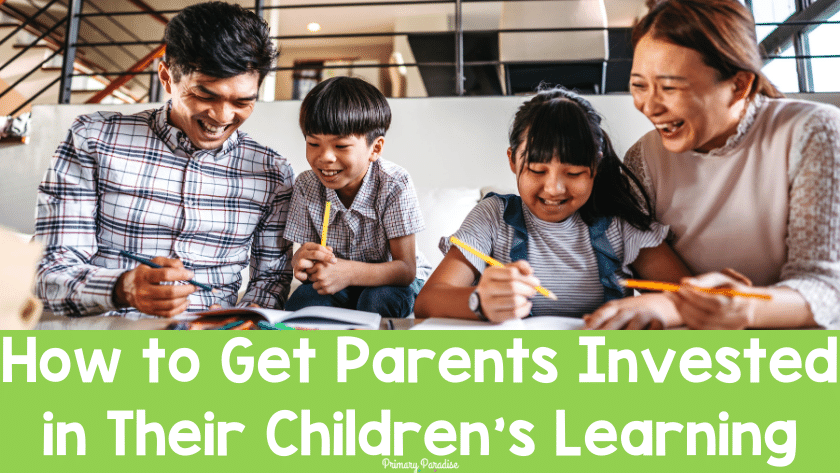As teachers, we want to give parents the opportunity to be invested in their child’s learning. Sometimes it’s difficult to make that happen, though. Here are some simple ways to increase parent involvement in your classroom.
A Disclaimer: Don’t Assume
Before we get started, I just need to say one thing. Please don’t assume that parents aren’t interested in their child’s education. Even if they seem unengaged, that doesn’t mean they don’t care. Some parents simply see it as the school’s job (and with our culture, can we blame them?). Many parents are overwhelmed. (I have 3 kids under 6. Hi. It’s me.) Some parents are studying and working multiple jobs. All parents are doing their best. So, while I do believe in getting parents engaged and involved, I also realize that parental involvement in school can be a huge privilege. There are times it isn’t always possible. We need to be understanding of this.
How to Get Students Invested in Their Child’s Learning
Communicate Often and Openly
Open communication is key. If you want parents to feel invested in their students’ learning, they need to know what they’re learning. Even if you don’t hear back from parents often, I guarantee most will read (or at least skim) the information you share with them. Whether you send a physical newsletter, email, or text or app updates, it’s important to communicate what you’re doing with parents on a whole. Personally, with so much technology readily available, it’s pretty easy to share classroom updates on a regular basis. Seesaw, Remind, a class Google Site and of course, good old fashion email are all fantastic options. In fact, with Seesaw or a class Google Site, you can even have students contribute to sharing. You don’t need to share every little thing with parents, but just quick updates about what students are learning, fun activities, and upcoming events can be helpful.
If you can go above and beyond whole class communication, it can be so effective to communicate with parents on an individual level as well. Of course, this doesn’t have to be a daily thing. In fact, unless there’s a particular issue or situation you’re dealing with, that’s overboard. However, if you can reach out to individually parents a few times each quarter (and not only to share issues or problems), it will mean a world of difference.
Explain Things They Might Not Understand
In my experience, a big reason parents might not be super invested in their children’s learning is that they just don’t understand what they’re learning. So many parents look at this crazy new math and the more advanced expectations for younger and younger graders and feel overwhelmed and confused. It’s a lot. And it’s been years and years since they’ve learned these things (if they even learned them). It’s also likely they learned it a totally different way. So, that’s one big reason they put their hands up and say “yep, not even going to try.” It’s not for lack of caring. It’s often for fear of doing it wrong.
That’s why I find it really helpful to send home quick explanations, or even create short videos of different skills and strategies students are working on. (Bonus, you can reuse these year after year.) If parents feel confident that they’re a helpful partner, they’re much more likely to engage. (I plan to share more about how to help parents with specific skills in upcoming posts.)
Ask for Help
Nothing makes people feel more involved, invested, and important then feeling needed. This is true for parents (and students!) as well. Not all parents will have the time, energy, means, or desire to help with different things in your classroom, but it’s a great way to include parents.
You can ask parents for help with all kinds of things. It can be big and small. You can ask them to come in (or record a video) reading a favorite book. You can crowdsource for anyone with expertise or experience on a topic you’re learning about. This is is an especially great way to bring in some real world learning connections. Are you learning about money? Ask a parent who owns a business to talk about the costs of owning a business. Are you learning about community helpers? Maybe a parent is works for waste management or is a nurse.
You can also ask parents for things like supplies, to help with class celebrations, or if they have other connections to people that would make great classroom visitors. Just keep in mind that you don’t want to make parents feel obligated in any way.
A really fun way to get parents involved is to ask parents to help celebrate student learning. You can invite them into the classroom to see what students are learning. Or, you can have an author’s afternoon or night where parents get to listen to their child read a recent writing piece. You can present a reader’s theater for parents over video chat (which is great for parents who might not be able to come in due to work).
And lastly, you can ask parents if they have anything in particular they’d like to help with. You never know what value they can bring to your classroom.
Ask for Input and Listen to the Feedback
A third way to get parents to be more invested into your classroom is to allow them to have some input. I don’t mean letting them plan lessons (although it WOULD be nice to have a break from that). What I mean is asking them for feedback. You can do this in casual interactions. You can also do this in a more formal way. At the end of a unit or marking period, ask parents for their feedback.
Ask them if their family talked about the things their child learned at home. You can ask them if it seemed too hard or too easy. And, you can ask them if they have anything they wish you did differently. And then, listen and think about what they say. Of course you don’t have to make every change they suggest, but they might have some really valuable insight. I can say that I didn’t truly understand the impact of homework until I was a parent myself. Parents have a unique and valuable perspective to offer.
Celebrate Families and Cultures
No matter the resources parents have to share, every family has their culture and values. Not only will parents enjoy sharing about their culture, but it will enrich and expand all of your students’ minds. You can invite parents to share children’s books they love and share their holiday, religious practices and important days. If you’re allowed, you can even have them share some of their favorite cultural and family dishes.
Be Understanding
Lastly, all parents are trying their best. As I said in the beginning of this post, their seeming lack of engagement or interest in their child’s education could be for many reasons. Or, it might just be the way you’re perceiving them. In reality, they might be very invested and committed to their child’s growth and education. You just need to give them options on how to contribute to their child’s learning.
Keep reading and learning about how to support parents:
- Free Reading Guide for Parents
- Free Math Guide for Parents
- Free Phonics Guide for Parents
- Free Science Guide for Parents
- What to Include in a Parent Newsletter
- Top 5 Ways to Send a Parent Newsletter
- Help Parents Understand Why Some History is History




